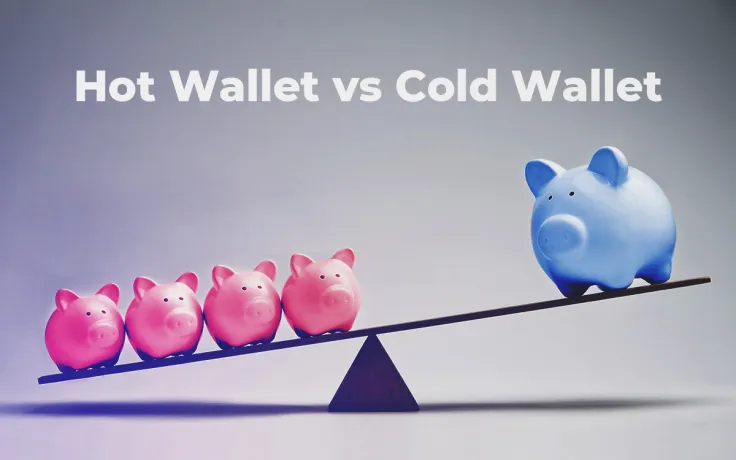
The traditional system of banking has taught us one crucial lesson- the business of securing your money is an important one. That’s why banks have bullet-proof doors, security guards, ultra-protected safes, sophisticated biometric scanners and sensors, etc. Thankfully, the major drawback of financial systems, human interference, has been eliminated by Blockchain decentralized systems.
Now, you can operate a financial model which eliminates dubious middlemen, exorbitant transfer fees and super-fast transaction speed. Cryptocurrency made all these possible. How do you store these cryptocurrencies? A cryptocurrency wallet!
What are cryptocurrency wallets?
Just like a conventional wallet where you keep your cash, a cryptocurrency wallet is a means by which you store your digital coins. There are two different types of wallet. We have the hot wallet vs. the cold wallet. Each wallet has its advantages and Achilles heel and choosing the best wallet is only a matter of getting adequate information on each. Let’s begin.
Hot wallets
Hot wallets or soft wallets are likened to checking accounts - where individuals can readily access their funds, make payments, and make instant transactions. It is always connected to the internet and this ensures accessibility. However, this particular feature can be a harbinger of misfortune.
A hot wallet is always connected to the internet and this gives some individuals with malicious intent ample time to perpetrate their fraudulent activities. Occurrences like phishing and hacking are now becoming increasingly prevalent, hence, it is advised that crypto-users limit the amount of funds they store on a hot wallet.
There are three main features of a soft wallet.
-
It is mostly free
-
It is easily accessible
-
A soft wallet is highly intuitive and easy to use
-
A soft wallet is always connected to the internet
Cold wallets
Cold wallets, on the other hand, are more secure. This is partly because it is not used as often as a hot wallet. Also, the security can be attributed to the fact internet connection is not direct (it is an offline storage). If you like, you can access the funds only once a year - it remains intact. Cold wallets can either be paper wallets or hardware wallets.
card
Paper wallet
Storing your coins in a paper wallet is likened to storing your coins on a computer which has never been connected to the Internet. These are extremely secure due to the fact that the computer used to generate the private keys are not prone to cyber-attack. It is as good as free and it gives you confidence that your funds will remain safe for a very long time.
Hardware wallets
When you compare cold wallets vs. hot wallets, the former might probably come out superior because of the security features of hardware wallets. They are powerful, convenient, and equally expensive. Although they are not as ubiquitous as their hot counterparts, these wallets are an excellent choice.
Comparison of hot and cold wallets
Now, let’s go through the different features of hot and cold wallets. Both wallets were built for different purposes, hence, this comparison will be as objective as possible.
Safety
When we talk about safety, a hot wallet is not totally the best choice. This is because it is always connected to the internet and this makes it vulnerable to hacking, phishing, etc.
Speed of transactions
Hot wallets are specifically made for instant payments, fast transactions, and flexible operations. Cold wallets, on the other hand, are made to hold large amounts of coins for a long period of time. When we compare cold wallets vs. hot wallets, the latter offers faster transaction times.
Support and integrations
Because of the nature of hot wallets, they are made to support a variety of coins, work well with APIs and other third-party integrations required.
Amount of funds operable
We have adequately established that hot wallets shouldn’t contain more funds than necessary while cold wallets are able to hold as much cryptocurrency as possible. This makes cold wallets superior for storing in bulk.
Types of hot and cold wallets
Hot wallets
1. Exodus
There are many crypto-wallets in the market, especially hot wallets. One feature which allows Exodus to stand out is the highly intuitive and easy to use the platform. It also has an attractive graphic design and a readily-available customer service team.
2. Coinpayments
This hot wallet supports over 75 cryptocurrencies, an astounding feat by any measure. Like most hot wallets, it is free and not cumbersome to navigate. Another reason for this wallet’s widespread acceptance is the ability to use it for making purchases online.
3. Electrum
Electrum is one of the oldest brands known for storing cryptocurrencies. If age is anything to go by, you can trust Electrum with your life’s savings. It works as a desktop wallet and still provides the user with every functionality required. Also, if you plan to change the PC on which it was installed, you just need to reinstall the software on a new PC and then input the seed (a string of random words) generated at first.
4. Blockchain.info
Blockchain.info, with 100 million transactions completed and 15 million users, might just be the most popular cryptocurrency wallet available. Why is it this popular? Transparency! They give you a double layer of security and they are impervious to the generated seed used to access the account.
Cold wallets
1. Trezor
Trezor, in a short while, has become one of the safest and most reliable cold wallets we have around. For people who have plans to invest huge sums of money in cryptocurrency, the Trezor is advised. The best characteristic of the Trezor wallet is that it is not cumbersome to carry about. It takes the shape of a very small digital calculator and it has an in-built screen which displays the pin and other sensitive information.
2. Ledger S Nano
This is another major player in the cryptocurrency industry and they offer the same level of security with an increased level of sophistication. For example, it uses its own Ledger Chrome application- which authenticates and authorizes transfers. The hardware wallet also boasts a sleek, trendy design which, like Trezor, has the screen to view the pin.
The battle of cold wallets vs. hot wallets is one which is fiercely contested. Is there a clear-cut winner? Well, that depends on your choices and preference. If you need cryptocurrency on the go; for payments and shopping, then the hot wallet is perfect for you. On the other hand, if your business is to purchase cryptocurrencies for a long period and then sell later, you can spare a few coins to invest in a quality hardware wallet.

 Dan Burgin
Dan Burgin Vladislav Sopov
Vladislav Sopov U.Today Editorial Team
U.Today Editorial Team